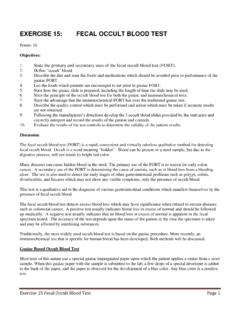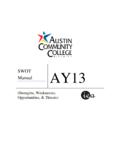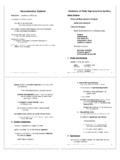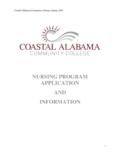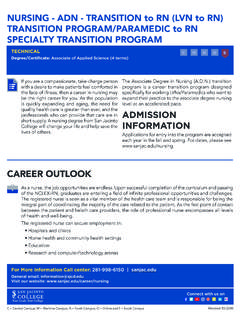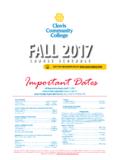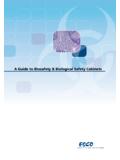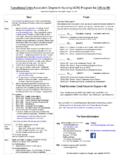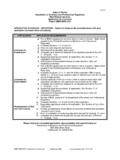Transcription of Syllabus Biology 2420 Microbiology for the Health …
1 Page 1 of 10 Syllabus Biology 2420 Microbiology for the Health Sciences Fall Semester 2018 Section: 58977 (001) (M/W) Lab 6:00 7:20 CYP1 1133 Lecture 7:30 8:50 CYP1 - 1133 Instructor: Rob Lewis Preferred Phone: Office hours: M&W 5:30 pm 6:00 pm CYP adjunct office cube or Micro Prep room By appointment: CYP - TBA For conferences outside of office hours, leave a voice mail message or e-mail me at rlewis3 (at) This Microbiology Class Web site YOUR source for information! : _____ Important dates: Last Day to Drop w/o a W = Sept 12th Final day to drop = Nov 26 th , Page 2 of 10 Syllabus BIOL 2420 Microbiology for the Health Sciences Summer Semester 2018 Course Description for BIOL 2420 The Microbiology for the Health Sciences class provides an overview of the microbial world and the techniques to study it.
2 Topics include the basic characteristics of fungi, algae, bacteria, and viruses. Special emphasis is placed on topics and applications that relate to humans. The skills required for this class include proficiencies in reading and writing as well as official prerequisites of one of the following, passed with a minimum grade of C : Biol 1406 Cellular & Molecular Biology OR Biol 2101/2304 Human Anatomy (Lec & Lab) OR Biol 2304/2101 (Human Anatomy) OR Bio 2404 Intro to Anatomy & Physiology OR Equivalent Note: This Biology 2420 class does not count as credit toward the Associate of Science degree in Biology . Texts/Materials The textbooks used as a basis for the Microbiology for the Health Sciences lectures are: Recommended: OpenStax Microbiology from Rice University = Free Book w excellent resources.
3 OpenStax Microbiology Publish Date Nov 01, 2016 Print ISBN-10: 1938168143 ISBN-13: 978--1--938168--14--7 Digital ISBN-10: 1-947172-23-9 ISBN-13: 978-1-947172-23-4 iBooks ISBN-10: 0-9986257-0-1 ISBN-13: 978-0-9986257-0-6 License: Microbiology by OpenStax is licensed under Creative Commons Attribution License Optional resources include: Bauman's Microbiology with Diseases by Body System, 4th edition - 2014 Author: Robert Bauman ISBN-13: 978-0321918550 ISBN-10: 032191855X Bauman's Microbiology with Diseases by Body System, 3rd edition - 2011 Author: Robert Bauman ISBN- 10: 0-321-69429-5, ISBN-13: 978-0-321-69429-4 Microbiology : A Systems Approach, second edition by Cowan, Marjorie Kelly; Talaro, Kathleen Park. 2008. McGraw-Hill: ISBN: 978-0-07-299528-2 Page 3 of 10 Recommended laboratory manual, either of the following: Microbiology Laboratory Theory and Application by Leboffe and Pierce.
4 2006. Morton Publishing Company. ISBN 0-89582-708-5. OR Photographic Atlas For The Microbiology Lab (looseleaf) 4th ed [2011] by Leboffe and Pierce. 2011 Morton Publishing Company. ISBN-10: 0895828723, ISBN-13: 978-0895828729 Other required materials include: Composition notebook for recording laboratory observations and exercises Sharpie brand marker for glass REQUIRED for safety -- closed toe shoes and long hair tied up during laboratory, laboratory Safety Glasses, lab coat or apron. Page 4 of 10 Course Outline Content Module Description Fundamentals of Microbiology Diagnosis and Infectious Diseases Host-Microbe Interactions & Host Defenses/Disorders Microbial Growth and Control Microbial Metabolism and Genetics Instructional Methodology This Microbiology for the Health Sciences course is taught through lecture in the classroom and as an interactive, hands-on learning exercise in the laboratory.
5 Course Rationale This course provides a survey of microorganisms. This survey includes the various microbial environments and the microbial interactions with multi-cellular organisms, especially humans. This course pays special attention to those microbes that are pathogenic to humans. The goal of Microbiology for the Health Sciences is to adequately prepare students for the Health science programs at ACC. Learning Outcomes Course Level: Specific skills and competencies are expected of students who successfully complete this course. These proficiencies include the following: Understand and explain microbiological processes in detail appropriate to this course, including: History, scope and trends in Microbiology Germ theory of disease and its development Aseptic procedures and materials for culturing and growth of microbes.
6 Enumerate and differentiate the groups of organisms included for study in Microbiology . Distinguish between eukaryotic and prokaryotic cell types. Energy acquisition and utilization by microbes and the function of enzymes in cellular activities. Microbial metabolism Fundamental nucleic acid chemistry including replication, genetic code, protein synthesis, metabolic regulation, and cellular reproduction. Microbial genetics, including sexual & asexual reproduction, transformation, transduction and conjugation in bacteria. Biotechnology related to microbes Symbiotic relationships (commensal, mutualistic, parasitic) Disease process, signs, symptoms, etiology, course, prevention/control, diagnosis, treatment of common human organ system infectious diseases Immunological processes, both (innate) nonspecific and specific (adaptive) Principles and methods of diagnosing disease and epidemiology Safe laboratory practices that include aseptic techniques and appropriate disposal or biological/biohazardous waste.
7 General Education: Observe phenomena, record and analyze data Construct graphs and/or tables from data Read and understand graphs to derive data/information Make inferences from data Demonstrate higher level thinking skills and problem solving Manipulate laboratory equipment appropriately Demonstrate safe work practices in a lab setting Work effectively as part of a team Demonstrate ability to understand and follow directions Page 5 of 10 Common Course Objectives Common course objectives are attached and can also be found on the Biology Department page: objectives/ Course Prerequisites The official prerequisites for Microbiology for the Health Sciences are: BIOL 1406 - Cellular & Molecular Biology OR BIOL 2401 - Anatomy & Physiology I OR BIOL 2404 - Intro to Anatomy & Physiology OR equivalents with lecture and laboratory.
8 A minimum grade of C is required, as defined in the Austin Community College Catalog. These prerequisites are strictly enforced. Additionally, all Biology courses require passing grades for the reading, writing, and math components of the basic skills test. Managing the Prerequisite Course Load: Many ACC Health Sciences programs require BIOL 2401, BIOL 2402, and BIOL 2420 as prerequisites. Due to the rigorous nature of each of these courses, it is not recommended to take two of them in one semester. The Biology department recommends taking these courses in the following sequence to balance the course load: 1. Semester 1: BIOL 2401 A&P I 2. Semester 2: BIOL 2402 A&P II 3. Semester 3: BIOL 2420 Microbiology for the Health Sciences Accommodation of Special Needs Students with special needs that are documented by letters from the Office of Students with Disabilities must meet with the instructor during the first week of class to make arrangements for accommodation of their needs.
9 Attendance Attendance in lecture is the student s responsibility, laboratory session attendance is mandatory. Your performance in the course depends on your attendance and participation. Students with unexcused excessive absences (2 or more) can be dropped from the class. Lectures The lecture schedule indicates textbook topic assignments and posted notes for each lecture period. Students are expected to read the assigned material before the scheduled date and be prepared to discuss assigned material in class. Students cannot use electronic devices during lecture without permission. Please! No laptops, electronic tablets or telephones. Do not mess with your smart Exams Students are expected to prepare for examinations that encompass all material scheduled, regardless of lecture coverage.
10 Exams are scheduled in advance and are administered in class on the scheduled dates. Each successive exam may contain previous material, thus necessitating continuous review. Exam Format Exams can include some combination of matching, multiple choice, short answer, fill-in-the-blank, and discussion or essay questions. There can also be charts, graphs, or tables to read, interpret or complete. Policies The following paragraphs describe policies to which this course adheres. Page 6 of 10 Missed Exams A missed exam can be made up with instructor permission if the absence is excused. The exam must be made up as soon as possible after the scheduled date of the missed exam. Make-up exams can differ in format and level of difficulty from that of scheduled exams. Outside Assignments In addition to reading and preparing for both lecture and lab classes, students are required to work on hand-out materials, such as case studies and exercises, and readings from the text book, throughout the semester.


